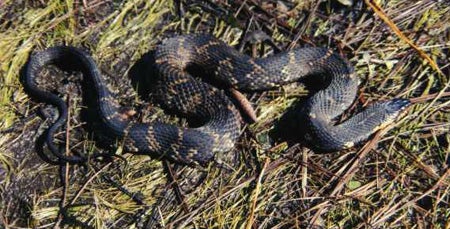SCIENTIFIC NAME:
Nerodia fasciata
STATUS:
Common across southern portions of Coastal Plain. Includes subspecies N.f. fasciata (banded water snake), N.f. confluens (broad-banded water snake), and N.f. pictiventris (Florida water snake) and intergrades. Lowest Conservation Concern.
DESCRIPTION:
The Southern water snake is a non-venomous snake normally less than 4 feet in length. Lengths up to 5 feet have been reported. It is commonly dark brown in color with lighter broad bands throughout the length of the body. The Southern water snake also has a dark stripe extending from the eye to the corner of its mouth. This snake often has squared reddish belly spots and is sometimes confused with the cottonmouth – which in contrast, has no reddish belly spots.
DISTRIBUTION:
The Southern water snake is found from North Carolina to eastern Texas; and along the Mississippi River Valley as far north as southern Illinois. There are 4 subspecies found in the eastern United States: the banded water snake; the Florida water snake; the broad-banded water snake; and the Gulf Coast salt marsh snake.
HABITAT:
As the name implies, Southern water snakes are found in association with aquatic habitats to include ponds, rivers, lakes, marshes, swamps, and temporary (ephemeral) ponds. Most often, they are found in shallow, still waters.
FEEDING HABITS:
Southern water snakes feed on a variety of aquatic prey to include frogs, small fish, crayfish; tadpoles, and salamanders. Salt marsh snakes feed on small crabs and fish.
LIFE HISTORY AND ECOLOGY:
Southern water snakes are primarily nocturnal and greatest activity is correlated with large choruses of frogs which attract the snakes to prime feeding areas. They often may be found under fallen logs, blown down tree crowns, and will use shallow underground dens. When cornered, the Southern water snake will defend itself rather aggressively and will deliver a non-venomous bite. Water snakes bear 9-50 young that are born live (not hatched) from June – August.
REFERENCES:
Harper and Row’s Complete Guide to North American Wildlife – Eastern Edition. 1981. Harper and Row Publishers, Inc. New York, NY. 714pp
AUTHOR:
Bill Gray, Supervising Wildlife Biologist, Alabama Division of Wildlife and Freshwater Fisheries






